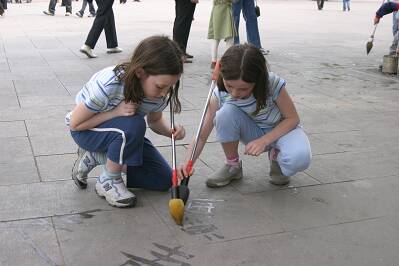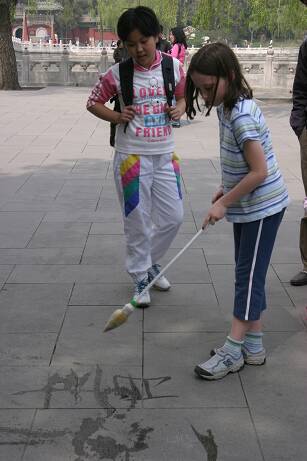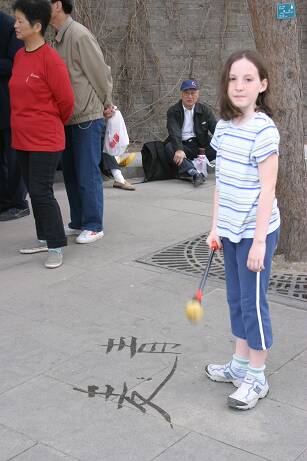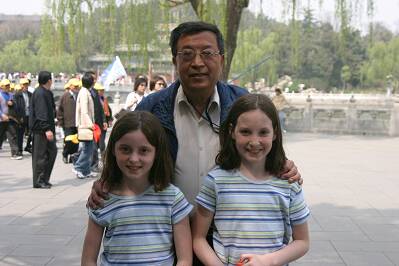Sidewalk calligraphy
The
girls were starting to go stir crazy after several days of running errands
and seeing friends during our April 2004 trip to Beijing.
So we decided to switch to enjoying some "quality family time"
by going on a fun expedition to
It
being a beautiful day, the park was filled with locals out enjoying the
weather with friends. It must
have also been graduation day from the local police academy, since the
park was crawling with youngsters in uniform, enjoying a day off with
their buddies. Luckily for
us, we were much more interested in them than they were in us; we thought
they were so cute that we asked if they would pose for a picture:

The
highlight of our park visit was a paddle around its beautiful lake, which
is always filled with a variety of watercraft that you rent by the hour.
We decided to go for a simple pedal-pusher.
We had lots of fun tooling around the lake, as our daughters took
turns pretending to be the Empress.

We
had lunch at Beijing’s famous “Imperial restaurant”, located on an island
in the middle of the park. The
waiters dress up like Palace slaves, the food is based on what the Emperor
ate, and the dining takes place in beautiful lacquer-wood pavilions with
gold leaf ceilings. Unfortunately,
what sounded terrific in the guide book turned out to be very disappointing
to the palate. We ended up
asking for the check before the others in our pavilion had even started
their second cup of tea!
Tired
from our aquatic adventure, and famished by the less than successful lunch
experiment, we decided to look for better food outside the park.
We were almost at the main gate when I saw an old man drawing Chinese
characters on the cement sidewalk with some sort of giant calligraphy
brush. Every so often he would
dip the brush in a 5 gallon paint drum filled with water, before continuing
with his sidewalk poetry.
None
of the passersby seemed to notice, but I was fascinated.
His calligraphy was beautiful.
I wondered where he had found the brushes.
There were a couple more brushes soaking in the paint drum, so
I grabbed one to look at it more closely.
The brush portion was a piece of foam rubber that had been whittled
by hand to resemble an oversized version of a calligraphy brush, complete
with its distinctive point. The
handle was a telescoping rod, the kind used to extend the reach of a brush
when you want to clean cobwebs from the corners of a high-ceiling room.
A thoroughly ingenious combination!
Seeing
someone interested in his hobby (or perhaps nervous that I was about the
steal the brush), the man rushed over.
He was surprised that I spoke Chinese, and even more surprised
when I wrote my Chinese name on the sidewalk with his brush.
The conversation quickly focused on the proper way to write the
"simplified" version of the second character in my 3-character
name, since I only knew how to write my name with “traditional” characters.
(The
written Chinese language exists in two versions: the first, or "traditional"
version, is the language of Chinese classics and is still used today in
Taiwan and in most overseas Chinese communities; the second, or "simplified"
version, was created under Mao's direction so that more people could learn
how to read and write. When
I began studying Chinese in the early eighties, traditional Chinese was
the only form taught at Yale – simplified characters were a curiosity
confined to the Communist PRC, and therefore not really worth studying
(or so I was told). Nowadays,
Americans interested in learning Chinese are taught the PRC’s simplified
version. Only scholars interested
in Chinese classics attempt the much harder task of memorizing the complex
traditional characters. How
times have changed!)
The man showed me all of the simplified characters which have the same sound as the one in my name. I finally pulled out my dictionary, and together we figured out which character was the right one. (Our confusion was not unusual. The Chinese language has about 30,000 unique written characters, but only about 300 unique sounds. Knowing the proper character to write is therefore sometimes a matter of a discussion that is far more complex that selecting between English-language homonyms such as “their”, “they’re”, and “there.”)
Meanwhile,
the girls decided it would be much more fun to grab the two remaining
oversized quills and try writing on their own.
As you might imagine, the sight of two fair-skinned Western girls
attempting to write Chinese characters on the sidewalk of a busy park
caused quite a stir. Like
me, they started with their names.
A curious crowd quickly formed, and the man walked over to see
what they were doing.

It
was a defining moment: the master calligrapher easily understood their
writing, and pronounced the characters as they were finished!
Thrilled that the man could read what they were writing, they kept
writing more characters from their lessons, egged on by the cackles of
approval from the master.
All
around us, the now-sizable crowd was engaged in an ongoing debate: were
the girls strange-looking Chinese kids? Had they been born and raised
in China? Were they adopted
from overseas by Chinese parents?
How was it possible that they could write Chinese characters?
Luckily, the girls were oblivious to their sensational appeal,
and happily continued to write, sometimes re-tracing their strokes when
the master showed them a much more elegant way to draw a character.
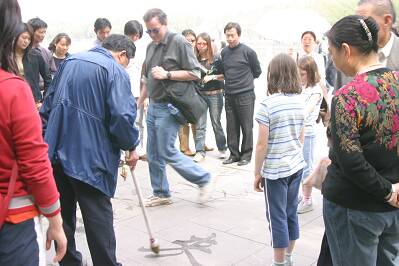
He
said that he used to teach calligraphy at the University, and now took
in private students. He made
these brushes as a sideline business, and used his sidewalk writing exhibition
as a way to find more paying students.
He
said the brushes cost six dollars each, which would be a hefty price in
any currency. But given his
story, and the fun of the entire interaction, I gladly bought two without
the obligatory haggling. Of
course, as I walked away, I heard him sell another brush to a local less
than a dollar. But who cares?
As
they say in those Mastercard commercials, it was a priceless moment.
Homepage Everyday Adventures Work Visit! Contact
